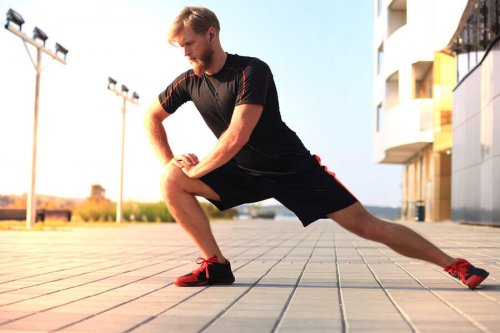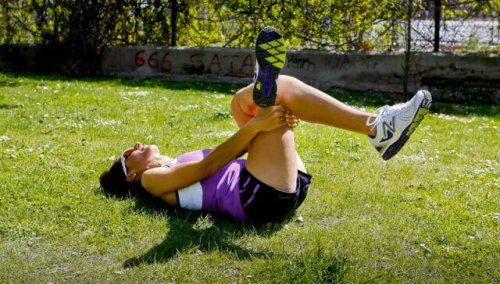Iliotibial Band: 4 Stretching Exercises to Relieve Hip Pain

The iliotibial band syndrome occurs when the tendon that runs along the outside of the leg swells or becomes irritated due to friction with the hip bone or knee. In this article, we’ll present some stretching exercises to avoid these pains.
About iliotibial band friction syndrome
First of all, we must locate the iliotibial band: it’s a thick band of tissue that passes through the outside of the thigh; from the buttock to the bone of the tibia. Its main objective is to move the hip laterally and straighten the knee.
When there’s friction between the iliotibial band and the bony prominence of the thigh bone, a syndrome occurs with the main symptom being pain on the outside of the knee. Gradually, this pain will increase. It may appear when you exercise and disappears when you finish the routine.
The iliotibial band friction syndrome presents itself due to repetitive rubbing. For this reason, we’re more likely to suffer from it if we run long distances or if we practice cycling, if we don’t have good muscle flexibility in our lower extremities, or if we don’t perform extension exercises before exercising.
You must bear in mind that this problem doesn’t go away by itself and that it requires specific treatment by a physiotherapist or sports doctor. This process includes massages, stretching, exercises to strengthen the area, and the use of a foam roller to release the tension in the iliotibial band.
At home, we can also apply ice when the area is swollen, rest the limb as much as possible, and wear comfortable and appropriate shoes, even when we don’t exercise.
The best stretching exercises for hip pain
If you suffer from the iliotibial band friction syndrome, you’ll need to stretch the hip, thigh, and knee areas well. Pay attention to these stretches:
1. Calf and soleus stretching exercises
It may seem like a simple movement that doesn’t do much. However, it has very good effects on the iliotibial band. To carry it out, you have to stand with your back straight and your hands resting on your waist. Take a step forward with the right leg and flex the knee.
Exert some pressure with the knee by moving it forward, but without going beyond the imaginary line of the toes. The torso should also be slightly inclined. Hold for a few seconds and change sides.

2. Stretching exercises for the psoas-iliac muscle
This muscle has a very important role in the positioning of the pelvis and spine, especially the lower back. Although, it’s one of the muscles that suffers the most due to a sedentary lifestyle and spending too many hours sitting.
To stretch and relieve hip pain, stand up and bring your arms across your chest. Then, take a long step with the right leg and flex the knee.
The left leg should be well stretched and diagonal to the ground. Exert pressure with the torso by moving it forward. Hold that position for 30 seconds and change sides.

3. Adductor stretching exercises
The main function of adductors is to bring the legs to the central axis of the body; therefore, they’re important for the positioning of the pelvis and lumbar spine. These muscles are usually shortened by lack of exercise, not stretching well, or practicing sports that require running or jumping.
To stretch the adductors, stand up with your hands at the sides of your waist. Take a lateral step with the right leg and leave it stretched. Flex the left knee slightly.
The weight of the torso goes to the left. You have to feel it working on the inside part of the right leg. After 30 seconds, change sides gently.

4. Stretching the pelvitrochanteric muscles
In many cases, these muscles are responsible for lumbago, back pain, and pyramidal syndrome. To stretch them, lie on your back, bend your knees and place the soles of your feet on the floor.
Afterwards, bring the right knee to your chest with your hands and lean the sole of your foot on the left knee. Try to apply pressure to the chest for a few seconds.

With these stretching exercises, you can reduce pain in the hip and pelvis, and in some cases, also alleviate the iliotibial band syndrome.
The iliotibial band syndrome occurs when the tendon that runs along the outside of the leg swells or becomes irritated due to friction with the hip bone or knee. In this article, we’ll present some stretching exercises to avoid these pains.
About iliotibial band friction syndrome
First of all, we must locate the iliotibial band: it’s a thick band of tissue that passes through the outside of the thigh; from the buttock to the bone of the tibia. Its main objective is to move the hip laterally and straighten the knee.
When there’s friction between the iliotibial band and the bony prominence of the thigh bone, a syndrome occurs with the main symptom being pain on the outside of the knee. Gradually, this pain will increase. It may appear when you exercise and disappears when you finish the routine.
The iliotibial band friction syndrome presents itself due to repetitive rubbing. For this reason, we’re more likely to suffer from it if we run long distances or if we practice cycling, if we don’t have good muscle flexibility in our lower extremities, or if we don’t perform extension exercises before exercising.
You must bear in mind that this problem doesn’t go away by itself and that it requires specific treatment by a physiotherapist or sports doctor. This process includes massages, stretching, exercises to strengthen the area, and the use of a foam roller to release the tension in the iliotibial band.
At home, we can also apply ice when the area is swollen, rest the limb as much as possible, and wear comfortable and appropriate shoes, even when we don’t exercise.
The best stretching exercises for hip pain
If you suffer from the iliotibial band friction syndrome, you’ll need to stretch the hip, thigh, and knee areas well. Pay attention to these stretches:
1. Calf and soleus stretching exercises
It may seem like a simple movement that doesn’t do much. However, it has very good effects on the iliotibial band. To carry it out, you have to stand with your back straight and your hands resting on your waist. Take a step forward with the right leg and flex the knee.
Exert some pressure with the knee by moving it forward, but without going beyond the imaginary line of the toes. The torso should also be slightly inclined. Hold for a few seconds and change sides.

2. Stretching exercises for the psoas-iliac muscle
This muscle has a very important role in the positioning of the pelvis and spine, especially the lower back. Although, it’s one of the muscles that suffers the most due to a sedentary lifestyle and spending too many hours sitting.
To stretch and relieve hip pain, stand up and bring your arms across your chest. Then, take a long step with the right leg and flex the knee.
The left leg should be well stretched and diagonal to the ground. Exert pressure with the torso by moving it forward. Hold that position for 30 seconds and change sides.

3. Adductor stretching exercises
The main function of adductors is to bring the legs to the central axis of the body; therefore, they’re important for the positioning of the pelvis and lumbar spine. These muscles are usually shortened by lack of exercise, not stretching well, or practicing sports that require running or jumping.
To stretch the adductors, stand up with your hands at the sides of your waist. Take a lateral step with the right leg and leave it stretched. Flex the left knee slightly.
The weight of the torso goes to the left. You have to feel it working on the inside part of the right leg. After 30 seconds, change sides gently.

4. Stretching the pelvitrochanteric muscles
In many cases, these muscles are responsible for lumbago, back pain, and pyramidal syndrome. To stretch them, lie on your back, bend your knees and place the soles of your feet on the floor.
Afterwards, bring the right knee to your chest with your hands and lean the sole of your foot on the left knee. Try to apply pressure to the chest for a few seconds.

With these stretching exercises, you can reduce pain in the hip and pelvis, and in some cases, also alleviate the iliotibial band syndrome.
All cited sources were thoroughly reviewed by our team to ensure their quality, reliability, currency, and validity. The bibliography of this article was considered reliable and of academic or scientific accuracy.
- Lavine, R. (2010). Iliotibial band friction syndrome. Current Reviews in Musculoskeletal Medicine. https://doi.org/10.1007/s12178-010-9061-8
This text is provided for informational purposes only and does not replace consultation with a professional. If in doubt, consult your specialist.








